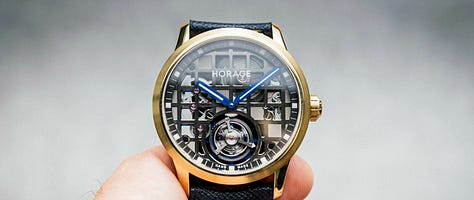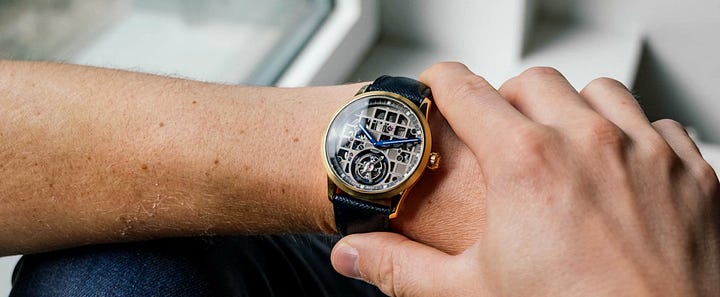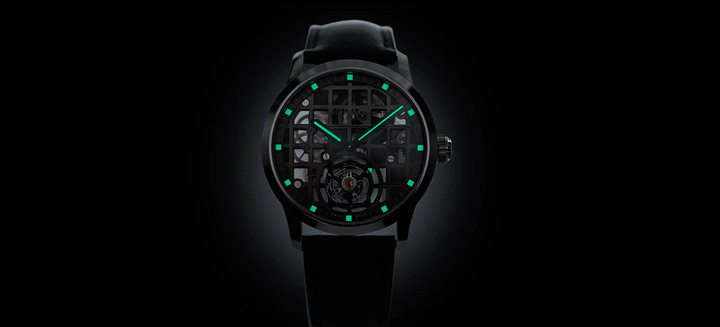The Tourbillon That Shouldn't Exist
How one independent watchmaker exposed the myths of haute horlogerie.
In the theatre of horology, the tourbillon has always been more than a device. It is choreography in miniature, a revolving stage where brass and steel enact a ritual of defiance against gravity.
When Abraham-Louis Breguet patented his invention in 1801, the aim was pragmatic: to improve the rate of pocket watches—which spent most of their time in vertical positions. Today, no one pretends that a wrist-worn tourbillon outperforms quartz, let alone atomic time. What survives is not its utility but its symbolism. The tourbillon became the embodiment of a question: how do you maintain wonder when precision has long since been solved elsewhere?
For centuries, the answer was exclusivity. Tourbillons were rare, costly, inaccessible. They belonged to kings, financiers, or those willing to underwrite the illusion that scarcity itself was proof of significance.
And then, in March 2020, in Biel, a small company called Horage announced its own tourbillon. Not at six figures. Not even at five. Less than ten thousand Swiss francs. A tourbillon for the cost of a mid-tier chronograph. Collectors blinked, scrolled back, wondering if it was satire.
It wasn't.
The tourbillon that shouldn't exist, suddenly did.
The Affordable Complication
Horage's Tourbillon 1 arrived when the world was folding inward. Luxury, in those months of global lockdown, leaned even harder on scarcity as a virtue. Yet Horage moved in the opposite direction, promising the most accessible Swiss-made tourbillon ever offered.
Early subscribers paid CHF 7,480. The number itself was a revelation, an uncomfortable reminder that perhaps much of haute horlogerie's price structure was not anchored in complexity but in theatre.
On forums, reactions split down familiar lines. Some scoffed—a tourbillon at that price can't be serious. Others praised the audacity—if they pull it off, the game changes. The watch unsettled not because of how it functioned, but because it raised a deeper question: if the tourbillon is no longer rare, does it remain meaningful?
Independent Ingenuity
The story could have ended at the announcement. It landed on April 1—a date that invites doubt—but collectors took it seriously, and Horage did too.
Their first plan, to use La Joux-Perret movements, collapsed. Many brands would have walked away. Instead, Horage designed its own caliber. In eight months—a blink by Swiss standards—the K-TOU was born: a flying tourbillon with silicon escapement, five days of autonomy, and stripped-back modernist architecture.
Even more subversive was the process. Horage documented every hurdle: delays, supplier disputes, pre-order financing. Buyers saw the scaffolding behind the curtain. Transparency was the model itself.
But here lies another paradox. Does transparency strengthen authenticity—or does it strip away the very mystery that sustains luxury? When every supply chain hiccup is visible, is the watch more honest, or merely less magical?
The Collector's Contradiction
Owning a Tourbillon 1 is not just possession, it is philosophy on the wrist.
For the seasoned collector, long trained to equate prestige with price, the contradiction is sharp. A CHF 7,500 tourbillon destabilizes the hierarchy. Does it diminish the aura of those six-figure cages locked in safes, or does it restore the complication to what it once was—a mechanical solution admired for ingenuity rather than cost?
Paradoxically, the Tourbillon 1 becomes its own kind of status object precisely because it refuses the old script. To wear it is to signal indifference to the theatre of Geneva, an allegiance instead to engineering independence. But even this indifference is a form of theatre. Collecting is never free of signaling. It only shifts the stage.
Long-Term Collectibility
The real intrigue lies not in the object, but in its future.
The Tourbillon 1 was never destined for catalog permanence. Its runs were finite, tied to subscription cycles. Once closed, production ended. On the secondary market, prices have held modestly, neither soaring into speculation nor collapsing into irrelevance.
But collectibility is not always immediate. Cult status germinates in obscurity, ripens in hindsight. Twenty years from now, today's buyers may see the Tourbillon 1 as a visionary wager...or a charming anomaly. Both futures remain plausible.
Market and Industry Implications
The Tourbillon 1 did not appear in a vacuum. For nearly two decades prior, the Swiss industry had been rehearsing its own uneasy dance with "affordable" tourbillons. In the mid-2000s, Chinese manufacturers began producing tourbillon movements at a fraction of the cost of their Swiss counterparts. A development dismissed by Geneva as irrelevant to serious collectors.
When TAG Heuer announced its Carrera Heuer-02T tourbillon in 2016 at under CHF 15,000, it was positioned as a provocation—proof that the complication could be industrialized. Yet even TAG's experiment relied on the scaffolding of a major group, and the pricing was still comfortably above what many enthusiasts could consider.
Horage's wager was different. It wasn't backed by an LVMH balance sheet, nor by a centuries-old name. It was an independent showing that the tourbillon could be conceived, produced, and delivered for less than many entry-level steel sports watches. The implication was unsettling: If a brand with a handful of employees could produce a credible Swiss tourbillon at this price, then what exactly underpinned the six-figure cages being paraded in Geneva each spring?
The grandes maisons, of course, did not answer directly. Instead, they shifted emphasis. Tourbillons became ever more encrusted with métiers d'art finishing, cloisonné enamel dials, hand-engraved bridges, and baroque casework. The value proposition migrated away from the rotating cage itself and toward the aura surrounding it. In a sense, Horage clarified the battlefield.
For collectors, this repositioning raises a deeper dilemma. If tourbillons can be made accessible, then their meaning depends not on their rotation but on the narratives spun around them. Horage forced the industry to reveal that luxury is sustained less by engineering than by the fragile scaffolding of myth.
Through a Collector's Eyes
For those who subscribed to the Tourbillon 1, the story began not in a boutique but in a browser window. Orders were placed during lockdown, deposits wired into uncertainty, faith extended to a brand that promised something the grandes maisons would not. The anticipation was not unlike commissioning a piece of independent art: months of waiting, updates trickling in by email, candid admissions of setbacks. Each delay, each supplier hiccup, became part of the narrative. To own the watch was to have participated in its making, however indirectly.
When the box finally arrived, the experience diverged again from the Geneva ritual. There was no salon ceremony, no velvet gloves. Just a plain package, inside of which sat a tourbillon that, by every functional measure, rivaled those costing ten times as much. What made it special was not only the rotating cage on the dial but the knowledge of what it represented: that scarcity could be challenged, that transparency could be a virtue, that an independent with a handful of engineers could bend the rules of Swiss watchmaking.
Living with the Tourbillon 1 reinforced the paradox. On the wrist, it behaved as any finely built watch should—precise enough, robust, quietly impressive to those who noticed. Yet the deeper pleasure came from knowing it was a complication carried lightly, without the burden of status theatre. It was a talking piece not because of its ostentation but because of its audacity. Conversations with fellow collectors often ended in a kind of bemused respect: "You really bought into that experiment? And they delivered?"
Years later, that remains the point. The Tourbillon 1 is remembered not as the most ornate or the most finely finished tourbillon, but as the one that dared to exist outside the script. For those who acquired it, the satisfaction lies in having witnessed the disruption firsthand—in having said yes to a watch that began as a joke, became a dare, and ended as a symbol.
Through a collector's eyes, the Tourbillon 1 is more than an object. It is participation in a moment when the rules were briefly suspended, and when owning a tourbillon meant engaging not just with a complication, but with a question: what, after all, makes a watch truly valuable?
What do you think? Did Horage democratize the tourbillon or diminish its mystique? Share your thoughts in the comments below.
If you enjoyed this deep dive into horological disruption, consider subscribing for more stories about the watches that changed the game, the collectors who shaped the market, and the ideas that drive our obsession with time itself.







